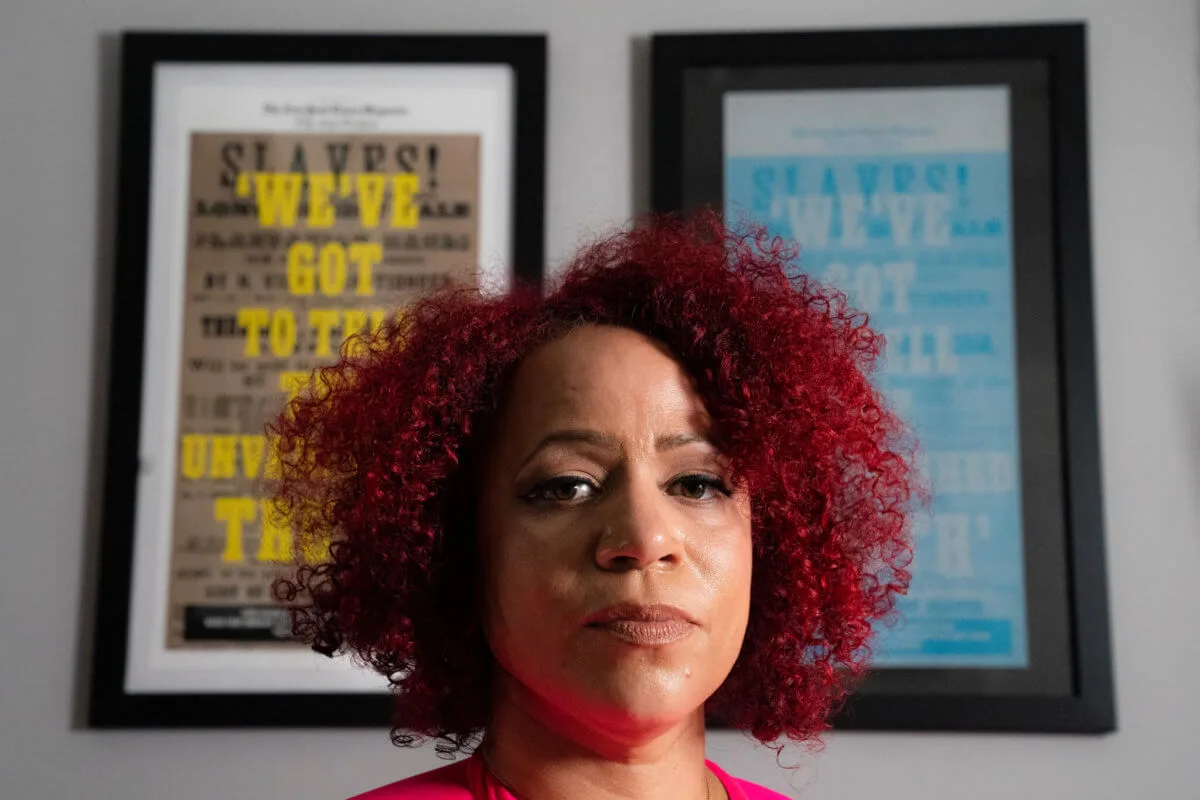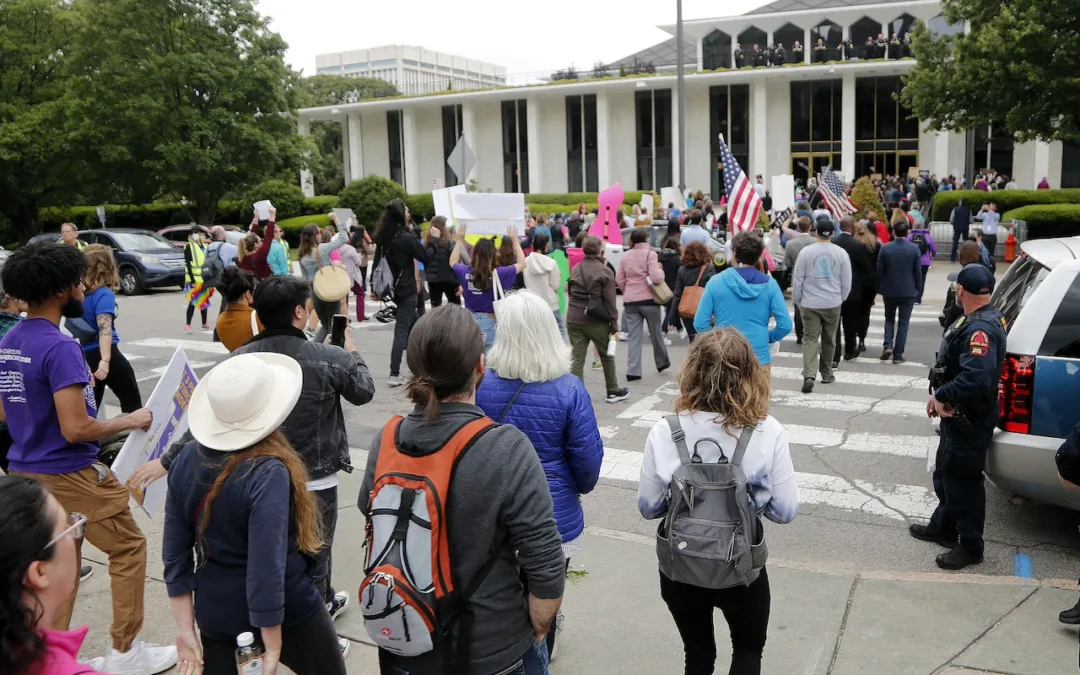
Journalist Nikole Hannah-Jones stands for a portrait at her home in New York, Tuesday, July 6, 2021. A controversy over tenure at UNC-Chapel Hill has supercharged debates in North Carolina about teaching the state's history of racism in K-12 and higher education. (AP Photo/John Minchillo)
The author of a North Carolina history book explains why it’s so crucial for the state’s K-12 students to understand our state’s history of racism.
This past Tuesday night, several dozen “Moms for Liberty” determined to “fight for the survival of America” converged on the Charlotte-Mecklenburg Schools board meeting.
They spoke with passion and anger about protecting their children from what they called “critical race theory” – which they described as deploying talk about our nation’s racial past and present to divide and shame young people.
Much was made of Dr. Martin Luther King Jr.’s dream that one day his own children would be judged not by the color of their skin, but by the content of their character.
North Carolina comes first to us. Subscribe to the free Cardinal & Pine newsletter.
On Wednesday morning, North Carolina Senate President Phil Berger threw his support behind such actions, presenting legislation designed to oversee teaching about race in North Carolina’s public schools.
What gets taught matters. As I sat and listened to Tuesday’s array of anxious, angry mothers, their words underscored for me the importance of learning about another group of North Carolina women – Black mothers forced to live in slavery, whose efforts to protect their children had far higher stakes and brought far harsher consequences. Their stories ground abstract ideas in real human experience, as all good history does.

‘The law said we were only things.’
The 19th century author and abolitionist Moses Grandy, who was born into slavery in Camden County, NC, just a few years after the American Revolution bestowed liberty on slaveholders but not on the men and women they enslaved, told one such story in his 1843 memoir:
“The master, Billy Grandy, whose slave I was born, was a hard-drinking man: he sold away many slaves. I remember four sisters and four brothers; my mother had more children, but they were dead or sold away before I can remember. I was the youngest. I remember well my mother often hid us all in the woods, to prevent master selling us. When we wanted water, she sought for it in any hole or puddle formed by falling trees or otherwise: it was often full of tadpoles and insects: she strained it, and gave it round to each of us in the hollow of her hand. For food, she gathered berries in the woods, got potatoes, raw corn, etc.
After a time the master would send word to her to come in, promising, he would not sell us. But at length persons came who agreed to give the prices he set on us. His wife, with much to be done, prevailed on him not to sell me; but he sold my brother, who was a little boy. My mother, frantic with grief, resisted their taking her child away: she was beaten and held down: she fainted; and when she came to herself, her boy was gone. She made much outcry, for which the master tied her up to a peach tree in the yard, and flogged her.“
Henry Singleton, born in New Bern, NC, a few years later, was sold away at 4 years old, while his mother, Lettis Singleton, was away doing her day’s work.
“That night when my mother came to get me and my brothers I was not there. I had been sold off the plantation away from my mother and brothers with as little formality as they would have sold a calf or a mule. Such breaking up of families and parting of children from their parents was quite common in slavery days and was one of the things that caused much bitterness among the slaves and much suffering, because the slaves were as fond of their children as the white folks. But nothing could be done about it, for the law said we were only things and so we had no more rights under the law than animals.”
As Singleton noted, these were far from isolated incidents. Enslaved people were the major form of wealth in many parts of North Carolina – often worth more than the land they were forced to work. The sale of husbands, wives and children was a significant source of income for North Carolina slaveholders, especially when the plantation economy expanded to the rich lands of Alabama and Mississippi. Across the South, hundreds of thousands of families were broken up this way.
Look at the photograph above, said to represent five generations of an enslaved South Carolina family. How many sons, daughters, grandchildren, aunts, uncles, nieces, nephews, cousins are missing? Why?
Such acts took place, as Singleton wrote, because enslaved Black people were not viewed as fully human by the legal system or by the slaveholders who helped write and enforce the laws. This view conveniently excluded the enslaved from soaring sentiments such as “all men are created equal” and meant they could be bought, sold, and whipped like cows and mules.
What does the past have to do with today?
These stories are hard to read. What makes them even harder are their connections with today, a time when so many other Black mothers have lost children in ways also sanctioned by law, through acts such as the shooting of Tamir Rice and Philando Castile, and the asphyxiation of Eric Garner.
This is the point. The racial hierarchy devised to justify enslaving other human beings did not magically vanish when slavery was abolished. Rather, it was shored up by new laws and institutions – Black Codes; separate-and-unequal Jim Crow segregation; textbooks that cast plantations as benevolent sources of employment; demeaning racial stereotypes conveyed in print, on movie screens and through the airwaves; a “war on drugs” that targeted Black communities and cast young Black men as “superpredators.”
There was a reason that Martin Luther King, Jr. spoke of his aspirations as a dream. He knew how much work it would take to root out the effects of centuries of aspersion and inequality. No one can wave a wand and make it so.
The many facets of racism’s legacy must be named and understood before they can be banished.
That is the kind of work that those at CMS, and at many other institutions, are attempting – and the kind of work that Phil Berger and Moms for Liberty seek to short-circuit.
The saving grace of Tuesday night’s board meeting was the large number of students, teachers and parents who showed up to counter talk of shame and division with support for a clear-eyed examination of the realities of our nation’s past and present, a concrete step towards the Constitution’s “more perfect Union.” We must keep up that work.
Along with stories of great wrongs, our past offers plenty of inspiration for determined action. Many enslaved families were never reunited, and millions of Black people died unfree. But Moses Grandy was able to purchase his freedom, make his way north and join the abolitionist cause, helping to spread the word of slavery’s evils and build the resolve to end it.
When Henry Singleton was seven, he ran away from the woman who had purchased him and headed home to New Bern, where his mother helped him hide from the men sent to recapture him. When the Civil War began, he made his way to Union lines, spent three years fighting, and eventually moved to New York, where he raised a family, published a memoir, and lived to the age of 103.
White North Carolinians fought slavery as well. Levi Coffin, the Quaker who gained worldwide fame for his work with the Underground Railroad, got his start as a boy outside Greensboro helping his father transport fugitives to freedom. His activism started when he was 7 years old, on the day he saw a group of Black men in chains marched past the family farm. One of them, whose face “denoted the deepest sadness,” explained that they had been sold away from their wives and children.
Dismayed, Coffin asked his father how such a thing could happen.
“In simple words, suited to my comprehension, my father explained to me the meaning of slavery, and, as I listened, the thought arose in my mind – ‘How terribly we should feel if father were taken away from us.’ This was the first awakening of that sympathy with the oppressed, which, together with a strong hatred of oppression and injustice in every form, were the motives that influenced my whole after-life.”
Moses Grandy, Henry Singleton and Levi Coffin , along with contemporary authors such as Nikole Hannah-Jones and Ibram X. Kendi, tell hard stories not to divide but to unite, to expose injustice and rally people to end it.
They seek not to shame, but to inform, sadden, anger and inspire, to foster courage and determination. In a world rife with its own injustices, we and our children need to spend more time with them, not less.
Politics

New Biden rule protects privacy of women seeking abortions
Under the new rules, state officials and law enforcement cannot obtain medical records related to lawful reproductive health care with the goal of...

How North Carolina’s legislative session could affect you
After a six-month break, the General Assembly returns for a new session on Wednesday, April 24. Though this round is expected to be relatively...
Local News

The 5 most believable UFO sightings ever reported in North Carolina
Read about five alien encounters that may forever remain unexplained. When you think of the most common places where you might hear a UFO sighting...

Good News Friday: It’s a good day to be a fan of the NC State Wolfpack
The men's and women's teams will compete for a national championship in college basketball this weekend. Plus: How to watch the solar eclipse, and...




